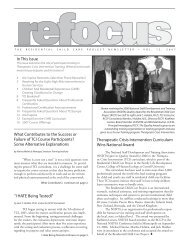The Therapeutic Crisis Intervention System - Residential Child Care ...
The Therapeutic Crisis Intervention System - Residential Child Care ...
The Therapeutic Crisis Intervention System - Residential Child Care ...
Create successful ePaper yourself
Turn your PDF publications into a flip-book with our unique Google optimized e-Paper software.
in the number of restraint episodes, and an increase in<br />
the knowledge and skill levels of staff ( See Table 1 on<br />
page 10).<br />
What Did Cornell Learn?<br />
During the 18-month implementation period in<br />
which Cornell worked with the residential agency,<br />
the following results were evident: increased staff<br />
confidence, greater consistency in approaching<br />
children in crisis, documented reductions in<br />
incidents, increased staff knowledge of crisis<br />
dynamics, and an in-house training system (See Table<br />
2 on page 11).<br />
Confidence<br />
• Staff members were more confident in their ability<br />
to manage crisis situations<br />
• Staff members increased their confidence as a team<br />
in handling crisis situations<br />
Consistency in approaching children in crisis<br />
• Staff members and supervisors indicated a more<br />
consistent approach to children in crisis<br />
Reductions in incidents<br />
• Evidence of reductions in fighting, serious verbal<br />
abuse, restraints, and assaults was documented in<br />
the three units that implemented TCI<br />
• Statistically significant reductions in physical<br />
restraints occurred in Unit B<br />
Increased staff knowledge and the development<br />
of an in-house training system<br />
• Staff members increased their knowledge of crisis<br />
intervention, and this increase in knowledge<br />
persisted up to 10 months after training was<br />
completed<br />
• Selected supervisory staff members learned basic<br />
and sophisticated techniques to conduct effective<br />
and long-lasting training programs<br />
Study Limitations<br />
<strong>The</strong>re are limitations with the evaluation<br />
methodology in this study. Although the agency<br />
appears representative of numerous small to medium-<br />
Research Foundations of TCI<br />
sized not-for-profit organizations throughout North<br />
America, a major question remains about the process<br />
of implementation and the incidence reduction<br />
results being generalizable to other organizations.<br />
<strong>The</strong> agency did volunteer for TCI implementation,<br />
and by doing so is a self-selected group. An argument<br />
could be made that this agency would have achieved<br />
the same results with any other crisis prevention and<br />
management system simply because it was ready to<br />
incorporate an agency-wide program.<br />
Other fundamental questions remain, for example,<br />
about whether the incidence reductions were due<br />
to TCI’s prevention and de-escalation strategies,<br />
or whether the existing leadership through tighter<br />
supervision and monitoring alone could have<br />
produced the same reduction. What is necessary is a<br />
methodology that incorporates a more sophisticated<br />
pre- and post-design with a sample of organizations<br />
in differing geographic areas throughout North<br />
America. <strong>The</strong> basic pre-post design might<br />
follow a staggered schedule of training for units<br />
within an agency, as well as for differing agencies.<br />
Implementing this design can help maintain the<br />
internal validity of the project, while supporting<br />
its evaluation and monitoring strategies. Such a<br />
staggered approach to training is often necessitated<br />
by institutional concerns of scheduling and resources,<br />
but can be used to the advantage of the evaluation<br />
effort. <strong>The</strong> strength of this design derives from the<br />
ability to compare baseline data with follow-up<br />
data within each group, but also adds a meaningful<br />
comparison between the follow-up data of like<br />
agencies and units. If these two comparisons yield<br />
similar results, then rival hypotheses regarding<br />
differences between the groups or temporal changes<br />
other than the training can be ruled out.<br />
Future evaluation design could well be carried out<br />
by independent evaluation staff. <strong>The</strong> introduction<br />
of control or comparison organizations into the<br />
evaluation methodology, and an independent<br />
evaluator would provide more confidence in any<br />
results.<br />
THERAPEUTIC CRISIS INTERVENTION SYSTEM: <strong>Residential</strong> <strong>Child</strong> <strong>Care</strong> Project, Cornell University 9



